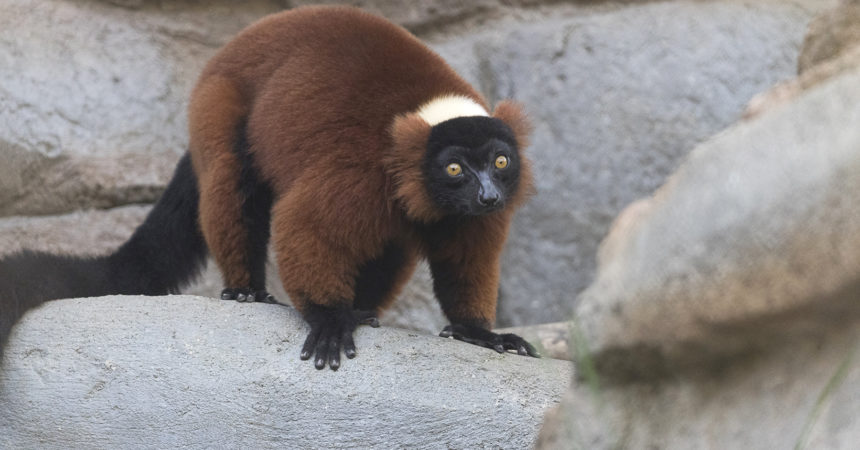A new group of red ruffed lemurs at the Madagascar Forest in Africa Rocks is making their presence known to their neighbors. Red ruffed lemurs Varecia rubra are known to be one of the most vocal lemur species. Their raucous, barking vocalizations serve various purposes such as announcing their location to other group members as they are foraging in the forest; claiming territory; and raising the alarm about predators and other potential dangers in the area. As this group of four move into their new territory and explore the new sights and sounds of their surroundings, San Diego Zoo visitors will certainly be hearing their loud calls.
This red ruffed lemur group consists of female Morticia, male Arche, and their twin male offspring Mahery and Mahitsy. Mahery, meaning “strong one” and Mahitsy, meaning “crooked” in Malagasy were born on May 15, 2019. When they were born, one was slightly stronger and the other one had a crooked tail, so they were given names reflecting those traits.
Red ruffed lemurs are the largest member of the Lemuridae (true lemur) family and have soft, thick, rust red hair coats, with white fur on the back of their neck and black sideburns. Looking closely, it’s possible to notice markings that differentiate each individual. For example, Arche has patches of white fur on both of his feet, while Mahery only has a patch of white on his left foot. Mahitsy, like his mother Morticia, doesn’t have white fur on either foot. So, as the group explores and plays it’ll be fun to look for those markings to determine which individual you are observing.
This spectacular diurnal frugivorous (fruit-eating) lemur is a sight to behold when feeding—they often hang upside down by their feet as they dive head first into flowers to collect pollen and nectar, along with any ripe fruit nearby. This behavior makes them an extremely important pollinator in the forests of Madagascar, and their presence is considered by scientists to be an important indicator of the health of a forest. It will be a thrill to watch the young red ruffs develop and display this behavior as they grow up.
They will be sharing their new home with two blue-eyed black lemurs, Akroyd and Belushi and it will be interesting to see how they take to each other and share overlapping home ranges as they would in the wild with other neighboring lemur species. This will be the first time the red ruffed lemur group will be introduced to another species of lemur, so I’ll be watching this introduction with interest and monitoring the reactions.
Unfortunately, red ruffed lemurs are classified as Critically Endangered primarily due to habitat loss and hunting. Fortunately, San Diego Zoo Global is committed to leading the fight to end extinction and bringing species back from the brink of extinction. By learning more about red ruffed lemur range distribution in the forest, researchers in Madagascar can help further protect their habitat from further encroachment.
When you visit the Zoo, be sure to come see our exuberant red ruffed lemur group and watch as they unveil their personalities and live their lemur life hanging out in the trees.
Yeleny Smith is a keeper at the San Diego Zoo. Read her previous blog, What A Rockin’ Year It’s Been!





